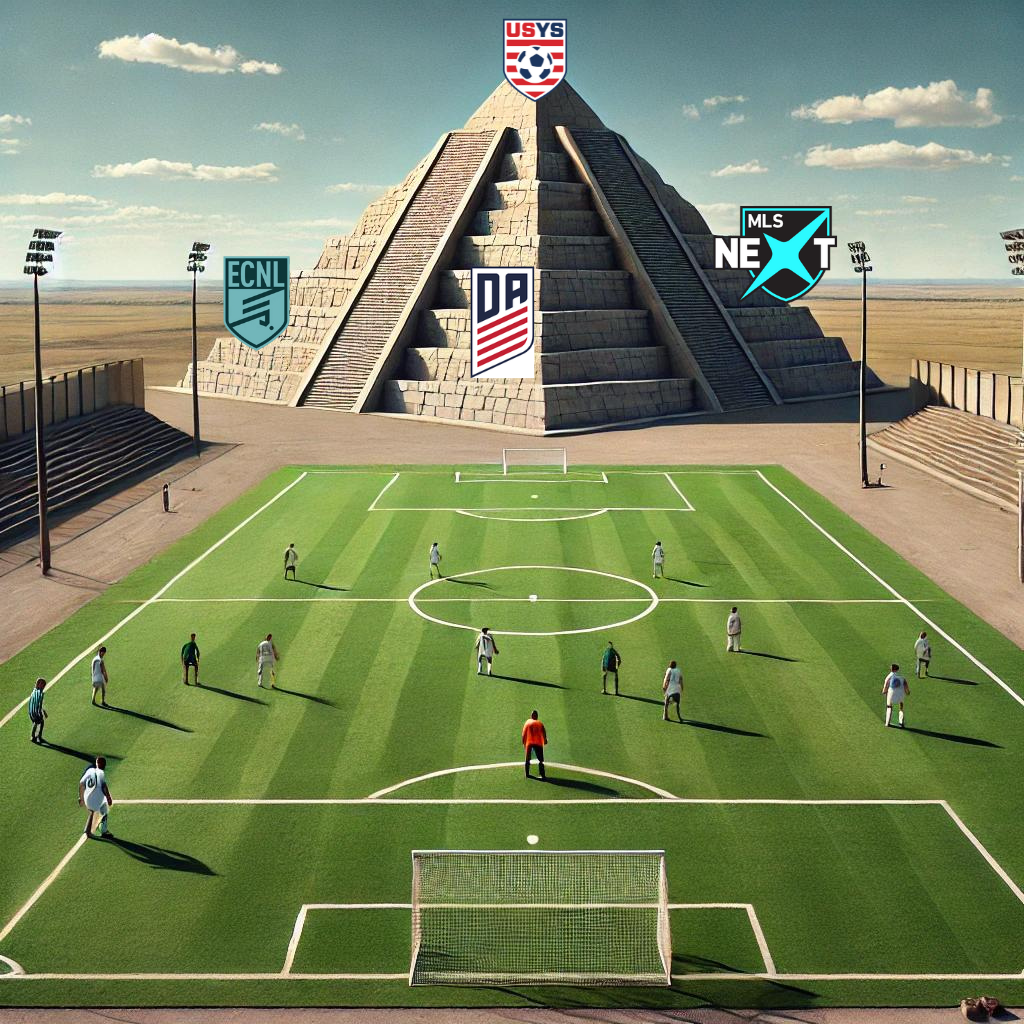Youth soccer in the United States has seen a significant rise in participation over the past few decades. With millions of children and teenagers hitting the soccer fields every year, understanding the structure and opportunities within the youth soccer system is crucial for parents, players, and coaches alike.
This article aims to demystify the US youth soccer pyramid, providing a comprehensive overview of its levels, leagues, and development paths.
Overview of the US Youth Soccer Pyramid
The US youth soccer pyramid is a hierarchical structure designed to organize and develop young soccer players across the country. This system ensures that players of all skill levels have access to appropriate levels of competition and training, promoting both participation and excellence in the sport.
The pyramid’s purpose is twofold: to provide a structured pathway for player development and to create a competitive environment that encourages growth and improvement. It begins with grassroots programs that introduce children to the sport and extends to elite development academies that prepare the most talented players for professional and collegiate soccer.
Understanding this pyramid is essential for anyone involved in youth soccer, as it helps navigate the various opportunities and challenges that players may encounter as they progress through their soccer journey.
Levels of the Pyramid
The US youth soccer pyramid consists of several distinct levels, each catering to different stages of player development and competition. These levels are:
Grassroots and Recreational Soccer
This entry-level tier focuses on introducing young children to the sport in a fun and supportive environment. Programs at this level emphasize basic skills, teamwork, and a love for the game.
Examples include local leagues, community programs, and organizations like the American Youth Soccer Organization (AYSO) and YMCA leagues.
Competitive Youth Soccer Leagues
As players develop their skills and passion for the game, they may move into more competitive environments. This tier includes travel soccer and club soccer, where players compete in regional and national leagues.
Major competitive leagues include the US Youth Soccer National League and the Elite Clubs National League (ECNL), among others.

Development Academies
The highest level of youth soccer development, these academies offer intensive training and competition for the most talented players. Development academies are often affiliated with professional soccer clubs and provide a direct pathway to collegiate and professional soccer. Notable programs include the US Soccer Development Academy and MLS NEXT.
Each of these levels plays a crucial role in the overall structure of youth soccer in the US, ensuring that players have access to appropriate levels of competition and development opportunities as they progress through their soccer careers.
Detailed Breakdown of Each Level
Recreational Soccer
Recreational soccer focuses on introducing the sport to young players in a fun, non-competitive environment. It emphasizes basic skills, teamwork, and enjoyment over winning.
Programs are often community-based and run by organizations such as AYSO and local YMCA chapters.
Competitive Leagues
Competitive youth soccer leagues are designed for players who have developed basic skills and are ready to compete at a higher level. These leagues offer structured competition and higher-quality coaching.
Notable leagues include the US Youth Soccer National League and the Elite Clubs National League (ECNL). These leagues provide regional and national competitions, allowing players to test their skills against the best in their age group.
Development Academies
Development academies represent the pinnacle of youth soccer in the US. These programs offer intensive, high-level training and competition, often affiliated with professional soccer clubs.
The academies focus on holistic player development, including technical skills, tactical understanding, physical conditioning, and mental toughness.
Key programs include the US Soccer Development Academy (now integrated into MLS NEXT) and other elite academies linked to Major League Soccer (MLS) clubs.
Pathways and Progression
Player Development Pathways
Players typically start at the grassroots level, where they learn basic skills and develop a love for the game. As they improve, they may join competitive leagues and eventually development academies if they demonstrate exceptional talent and commitment.
This progression allows players to develop at their own pace while accessing appropriate levels of training and competition.
Transition to Professional and College Soccer
College Recruitment and Scholarships
Many players aim to play college soccer, which can provide scholarships and a pathway to professional opportunities. College scouts often attend competitive league and academy matches to identify potential recruits.
Professional Contracts and MLS Academies
The most talented players may be offered professional contracts by MLS clubs or other professional teams. Development academies, particularly those affiliated with MLS, are a critical step in this pathway, providing exposure to professional scouts and high-level competition.
Benefits of the Pyramid Structure
Player Development
The US youth soccer pyramid supports the growth and development of players by providing structured progression. Each level of the pyramid is designed to offer age-appropriate training, competition, and development opportunities. This ensures that players develop essential skills and knowledge at each stage of their journey.
Opportunities for All Skill Levels
The pyramid provides opportunities for players of all skill levels. Whether a player is just starting in recreational soccer or aiming for the highest levels in development academies, the pyramid ensures there is a place for everyone to play and develop according to their abilities and ambitions.
Community and Engagement
Youth soccer fosters community engagement by bringing together players, families, coaches, and fans. This sense of community can enhance the player’s experience, providing a supportive environment that encourages participation and development.
Local leagues and clubs often form the backbone of these communities, promoting values of teamwork, sportsmanship, and healthy competition.
Challenges and Criticisms
Accessibility and Inclusivity
One of the primary challenges of the US youth soccer pyramid is the pay-to-play model, which can limit accessibility for lower-income families.
This model often requires significant financial investment for participation in competitive leagues and development academies, potentially excluding talented players who cannot afford these costs.
Balancing Competition and Development
There is an ongoing debate about the balance between competition and development. Some critics argue that an overemphasis on winning at younger ages can hinder long-term player development.
Ensuring that coaches and programs focus on skill development, enjoyment, and learning rather than just results is crucial for the holistic development of young players.
Resource Disparities
There are significant disparities in resources and facilities available to different clubs and regions. Wealthier areas and clubs may have access to better facilities, coaching, and support systems, while less affluent areas may struggle to provide the same level of opportunities.
Addressing these disparities is essential for creating a more equitable and effective youth soccer system.
Tips for Navigating the Pyramid
For Parents and Players
Choosing the Right Club and League
Research clubs and leagues to find the best fit for the player’s current skill level, goals, and family budget. Look for programs that emphasize player development, provide qualified coaching, and offer a supportive environment.
Understanding Commitments and Expectations
Be aware of the time, financial, and travel commitments required at different levels of the pyramid. Ensure that the player is ready and willing to meet these commitments and that they align with family priorities and schedules.
Long-Term Planning
Consider the player’s long-term goals, whether they aim to play in college, professionally, or simply enjoy the sport recreationally. Plan accordingly, seeking opportunities that support these goals and provide the necessary development and exposure.
For Coaches and Administrators
Supporting Player Development
Focus on creating a positive, development-oriented environment that prioritizes skill development, enjoyment, and learning. Encourage a growth mindset and provide opportunities for players to challenge themselves and improve.
Building Successful Programs
Develop programs that offer clear pathways for player progression within the pyramid. Ensure that your coaching staff is well-trained and that your program aligns with best practices in player development and coaching.
Engaging with the Community
Foster strong connections with the local community, including schools, other sports programs, and families. Engaging with the community can help build support for your program, attract new players, and create a positive environment for all involved.
Conclusion
The US youth soccer pyramid is a comprehensive system designed to support the development of young soccer players at all levels. By understanding the structure and opportunities within the pyramid, parents, players, and coaches can make informed decisions that enhance the player’s experience and development.
From grassroots and recreational leagues to competitive youth soccer leagues and elite development academies, each level of the pyramid plays a vital role in fostering talent and promoting the sport.

